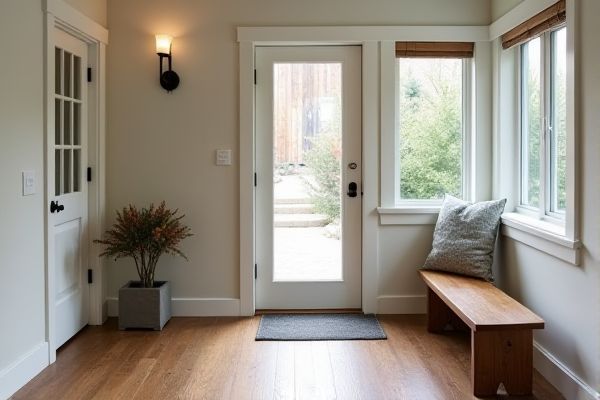
Mudroom heated floors provide consistent warmth that enhances comfort and prevents cold, damp conditions often found in entryways, while unheated floors may contribute to chilly toes and potential moisture-related issues. Discover how your choice between heated and unheated mudroom flooring can impact functionality and comfort by reading the rest of the article.
Table of Comparison
| Feature | Heated Mudroom Floors | Unheated Mudroom Floors |
|---|---|---|
| Comfort | Provides warmth and comfort, especially in cold climates | Cold and less comfortable during winter |
| Energy Efficiency | Uses electricity or hydronic systems, may increase energy bills | No additional energy consumption |
| Installation Cost | Higher initial cost due to heating system installation | Lower upfront cost |
| Maintenance | Requires periodic system checks; generally low maintenance | Minimal maintenance required |
| Flooring Options | Compatible with tile, stone, and some engineered floors | Compatible with all flooring types |
| Impact on Home Value | Can increase property value and appeal | No significant impact on property value |
| Moisture Control | Helps reduce moisture and mildew in wet mudrooms | May be prone to moisture retention and damage |
Introduction to Mudroom Flooring Options
Mudroom heated floors offer superior comfort by providing consistent warmth and reducing moisture buildup, making them ideal for colder climates or busy households. Unheated floors in mudrooms are often more cost-effective initially but may become cold and damp, leading to potential discomfort and increased maintenance. Choosing between heated and unheated flooring depends on your lifestyle needs, budget, and the level of comfort you desire in your mudroom space.
What Are Heated Mudroom Floors?
Heated mudroom floors use embedded electric or hydronic heating systems beneath the surface to provide consistent warmth, preventing cold floors and enhancing comfort during entry and exit. These floors improve energy efficiency by reducing the need for supplemental heating in transitional spaces prone to moisture and dirt accumulation. Compared to unheated mudroom floors, heated options reduce the risk of ice formation and rapid temperature fluctuations, offering a more comfortable and safer environment.
Benefits of Heated Mudroom Floors
Heated mudroom floors provide consistent warmth, preventing cold, damp surfaces that can cause discomfort and increase humidity levels. These floors reduce the risk of mold and mildew growth by maintaining dry conditions and improving overall indoor air quality. Energy-efficient radiant heating also helps lower utility costs compared to traditional heating methods, enhancing comfort and functionality in mudroom spaces.
Drawbacks of Heated Mudroom Floors
Heated mudroom floors can increase energy costs significantly due to constant warming requirements, impacting your utility bills. Installation of radiant heating systems is often complex and expensive, especially in existing mudrooms, leading to higher upfront costs. Additionally, these systems require regular maintenance and may malfunction, causing inconvenience and costly repairs compared to unheated floors.
Advantages of Unheated Mudroom Floors
Unheated mudroom floors offer cost-effective installation and reduced energy consumption, making them ideal for budget-conscious homeowners. These floors are simpler to maintain and tend to have fewer mechanical issues compared to heated options. If your mudroom is used primarily for short periods or as a transitional space, unheated floors can efficiently meet your needs without unnecessary energy expenses.
Potential Downsides of Unheated Mudroom Floors
Unheated mudroom floors can lead to uncomfortable cold surfaces, especially during winter months, increasing the risk of slipping on icy or wet floors. Moisture accumulation from boots and outerwear often causes dampness, which can result in mold growth and damage to flooring materials. Your mudroom may also experience higher energy costs as the cold floors lower the overall temperature, forcing heating systems to work harder.
Installation Costs: Heated vs. Unheated
Heated mudroom floors typically involve higher installation costs due to the need for electrical wiring or hydronic tubing beneath the surface, as well as potential adjustments to the subfloor. Unheated floors have lower upfront expenses since they require only standard flooring installation without additional heating components. You should consider these cost differences alongside long-term energy savings and comfort when deciding between heated and unheated mudroom floors.
Energy Efficiency and Long-term Savings
Heated floors in your mudroom provide superior energy efficiency by distributing warmth evenly and reducing reliance on forced-air heating systems, which can lead to lower utility bills over time. Unlike unheated floors that can cause heat loss through cold surfaces, radiant heating minimizes energy waste and maintains a comfortable temperature with less effort. Investing in heated flooring results in long-term savings by enhancing home insulation and potentially increasing property value due to its modern energy-saving benefits.
Comfort & Practicality in Daily Use
Heated mudroom floors provide superior comfort by maintaining warmth underfoot during cold months, preventing discomfort and dampness often experienced with unheated floors. This feature also aids in faster drying of wet footwear and outerwear, enhancing practicality and reducing moisture-related issues such as mold and mildew. In daily use, heated floors create a welcoming, functional space that supports easy maintenance and improved overall hygiene.
Which Mudroom Floor Type Is Best for Your Home?
Heated mudroom floors offer superior comfort by providing consistent warmth that prevents cold, damp surfaces and reduces moisture-related issues, making them ideal for homes in colder climates. Unheated floors, while more budget-friendly and easier to install, may result in chilly, less comfortable spaces and increased risk of mold or mildew due to moisture retention. Choosing the best mudroom floor depends on your climate, budget, and how much you prioritize energy efficiency and year-round comfort.
 homyna.com
homyna.com